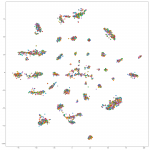
Been a while since the last post! Here it goes! We currently have three students working on the project. We had a fourth last spring, but she has since graduated. For the rest of us left, we now have…

Previous post on Louvain On node2vec, we were able to successfully run our weighted co-occurrence graph. After using PCA with TSNE to reduce the dimensions shown, the node2vec model has more well-defined clusters here than on our previous bipartite graph….

Previous post From our previous post, we’ve discovered that the community detection algorithms were mainly grouping based on document/location. This time, we created a new weighted co-occurrence graph of all the people in all documents, similar to the Les Miserables…

Previous post: Creating a Network Graph There are a number of definitions for what it means to belong to a community. Usually, people are involved in multiple communities, but they have stronger ties to a few of those communities because they know…

Previous Post: Data Processing with NLTK From the ccp_people.csv file, we built a simple social network using Gephi. This was originally a undirected graph where each edge represented a connection that two people were in the same document. We first calculated…

The Python package, NLTK, is a great starter kit for anyone wanting to learn natural language processing. It can easily perform functions in any text such as finding parts of speech, tagging entities of any kind (person, place, company, etc.),…
For the past several years, the DH Lab has been working on a project, TOME, aimed at visualizing the themes in a corpus of nineteenth-century newspapers. In designing this tool, our central motivation was to be able to more clearly…

We are three new students who joined DILAC lab and are continuing where the project left off from the summer semester. Much of the fall 2017 semester has been a catch up phase to learn about how the project got…

As described previously the membrane switch controller can be created by separating two sets of conductive traces with flexible insulating material in between: Creating this ‘holes’ layer was a seemingly straightforward yet laborious process – cutting 900 holes precisely ain’t…

You must be logged in to post a comment.